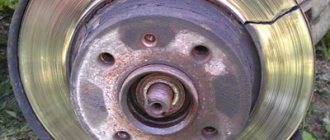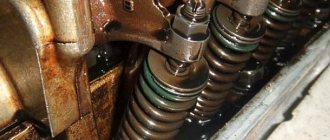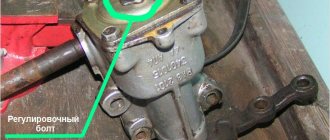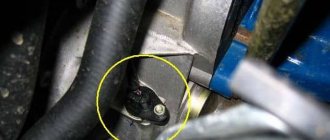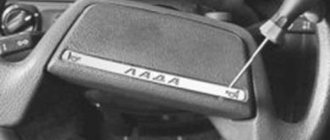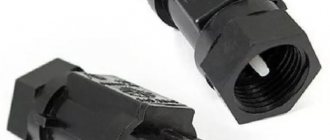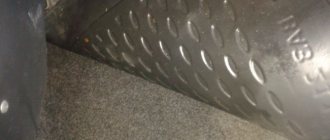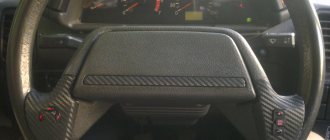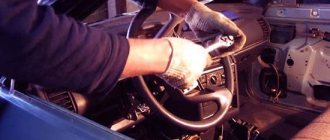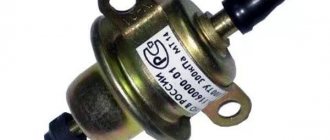The braking system is one of the main mechanisms in a car, responsible for reducing speed and stopping the vehicle. If a car does not go anywhere with a faulty engine, then if there is a problem with the brakes, movement becomes dangerous not only for the driver and passengers, but also for other road users. In this article we will look at the possible reasons for the brakes beating, which indicates some kind of malfunction.
The brake pedal hits when braking - these are extraneous vibrations going to the pedal at the moment of braking. There is a directly proportional relationship between pedal pushes and speed, that is, the higher the speed, the more intense the “response” to the pedal will be. If the speed is over one hundred kilometers per hour, with heavy braking, vibrations can also transfer to the steering wheel and car body.
Why does the steering wheel shake? 7 Main Causes of Steering Wheel Vibration
Care and attention to the technical condition of the car is our direct responsibility. And it doesn’t matter how we feel about it, whether it’s a “workhorse” for us, a means of transportation or a luxury item. First of all, its serviceability is our safety.
And one of the reasons to pay serious attention to the car is the vibration of the steering wheel when driving, or, as experienced drivers say, the beating of the steering wheel. It is expressed in completely different ways and at different speeds, for some at 30 km/h, and for others at 70 km/h. It doesn't really matter. What matters is the fact that there is something wrong with the mechanical part of the car. Let's look together at the seven main causes of this vibration and how to eliminate them. And I’ll tell you about another interesting reason, which is rare, at the end.
Why does the steering wheel shake when braking and how to fix it?
Vibration of various elements of the car inevitably occurs during operation, when the moving parts of the chassis and transmission gradually wear out. But among such malfunctions, there is one dangerous malfunction - the steering wheel wobbles when braking. The more the steering wheel jerks after pressing the brake pedal sharply, the higher the likelihood of losing control and flying off the road at a decent speed. To avoid the described emergency situation, it is worth studying the nature of the problem and how to solve it.
Snow and dirt in the wheel
The first and most common reason is snow freezing or dirt sticking to the inside of the wheel rim. This usually happens in winter. Due to lumps of snow and dirt stuck to the rim, wheel imbalance occurs, which causes quite strong vibration not only in the steering wheel, but throughout the entire body. The help of specialists is not required here; it is enough to find an overpass and remove everything that is unnecessary from the disks using a metal brush. You can also remove each wheel separately and perform the same operation, as you wish. The only point that cannot be missed is that when removing with a brush or something else, do not dismantle the balancing weights, which are very often glued to the inside of alloy wheels, so that you do not have to go to a tire shop and re-balance.
Wheel mount
Fastening a wheel or tightening it with bolts and nuts is perhaps the most dangerous reason why vibration can occur at low speed. Through her fault, we can crash if the fasteners fall off while driving and the wheel flies off the car. Therefore, if you feel vibration, do not be lazy and check whether all the wheels are tight. You can also contact the service, where specialists will do this using a special tool. After all, in addition to the risk of getting into an accident, poor wheel fastening can lead to rapid wear of suspension parts. And this, in turn, is not a timely expense.
Tire pressure
Another factor that can cause the steering wheel to wobble is tire pressure. Vibration will appear at speed, although for this reason it occurs more often throughout the body. The steering wheel is almost not noticeable. If there is a difference in pressure in the wheels, the car will also pull to the side. In other words, you will keep the steering wheel straight, and the car will drive either to the left or to the right. This can be solved by simply equalizing the pressure at any gas station, tire shop, or wherever there is a tire inflation hose.
Summarizing
The vibration of the brake pedal when braking is one of the symptoms of a malfunctioning brake system. The consequences can be very different from simple wear of parts to the creation of emergency situations due to brake failure.
For full operation of the brake system, full contact between the surface of the friction lining of the pad and the brake disc is necessary. If replacing worn parts helped only temporarily, maybe you should think about changing your driving style, because it is your driving style that affects the service life of the parts.
You should also not allow the temperature of heated elements (discs and calipers) to change; try to avoid puddles after braking, and also allow the brakes to cool before washing the car. To avoid breakdowns, you should visit service stations more often to check the performance and preventive maintenance of brake mechanisms, repair them in a timely manner, and also periodically inspect your brakes yourself.
You can test and find any faults in the brake system in your car on an empty section of the road, away from houses and pedestrians in order to avoid accidents.
First of all, you should carefully monitor the car’s braking process, listen to see if there are any extraneous noises or squeaks, whether the braking is uniform, or whether the direction of movement changes during sudden braking.
No matter how well the active and passive safety of a car is developed, if the brake pedal hits when braking, the car becomes dangerous both for the driver and for other road users. Moreover, the higher the speed, the stronger the vibration of the pedal, which can become an unpleasant surprise in an emergency situation. Let's look at why this might happen.
Author of the article: mudriy_lev Specialization: repair of auto generators and servos in cars. Place of work: service center. Experience: 2 years. Education: higher education - electrical engineer, secondary specialized education - mechanical assembly mechanic.
Wheel imbalance
Wheels, like tires, although they have an ideal appearance, and even on rolling machines their shape is absolutely ideal, unfortunately, they have different densities of the material from which they are made. For example, the density of the alloy in the disk may differ in different places, which in turn will add or decrease weight in this place. The same is true with tires. Thus, when assembling the wheel, we get an imbalance caused by different weights in different places of the wheel as it rotates. Which in turn will lead to vibration in the steering wheel at speeds of approximately 80 km/h. This can be corrected by balancing the wheels at a tire shop.
Crooked wheels
Although roads in big cities are getting better, this is not happening everywhere. And here and there we come across potholes, potholes and holes into which we drive with our wheels, thereby damaging either tires or wheels. And it happens that both of them happen, so much so that it is no longer possible to restore them. So, after such damage, strange vibrations appear, which can also manifest themselves both in the body and in the steering wheel. To determine this, it is necessary to remove the wheels and conduct a visual inspection of the rim for dents and deformations. But more accurately, this can be seen on a balancing machine in a tire shop, when the wheel rotates. There you can clearly see whether the disc is hitting or whether the tire itself is bent. Since the tire has a metal cord inside, with a strong impact it breaks and a lump or hernia appears on the wheel, as a result of which the rubber is deformed and becomes egg-shaped. This can be corrected in this way: replace the tire and roll the disc on a rolling machine.
Chassis
Operating a car is, of course, an individual thing. The more carefully we drive, the longer our car will serve us. But sooner or later, running parts and assemblies begin to wear out. And this, in turn, is also one of the reasons for steering wheel vibrations. Tie rod ends and rods, wheel bearings and steering rack. As soon as wear and play appear in the suspension, it begins to transmit to the steering wheel all the unevenness and defects of the road surface on which we are driving, thus creating steering runout. And also causing vibrations in the body. The solution to this problem is diagnostics and repair of the chassis and steering.
Suspension faults
Ball joints are devices related to the suspension that support the vertical position of the front wheels. These supports are subject to rapid wear, which depends on the vehicle's driving technique and the quality of the roads. Vibration of the steering wheel is one of the signs of wear on the ball joints. The picture shows the ball joint of the wheel.
Faulty CV joints not only make noise and crunch, but also provoke unnecessary vibration. A crunch will indicate that the problem is with the grenades. Shock absorber struts are designed to dampen any vibrations and beating. If the racks are faulty, they will not do their job.
Steering wheel wobble also occurs in the steering mechanism itself. The following are malfunctions of the steering mechanism that cause the steering wheel to wobble:
- faulty steering tips, play in the steering rack;
- worn steering gear bearings;
- the steering shaft (steering cardan) has exhausted its service life and is out of order.
Special diagnostic equipment in a car service center will help you find the true reason why the steering wheel shakes at speed.
Vibrations when braking
Since front disc brakes appeared, the list of causes of steering wheel vibrations has been supplemented with one more. Often the cause of this malfunction is aggressive driving (fast acceleration and sharp deceleration). By squeezing the brake pedal at high speed, we heat up the brake disc to such an extent that it takes the shape of a figure eight. Brake pads begin to follow the shape of the disc when braking. Vibration occurs in the wheel, which is transmitted to the steering wheel through the steering. This is how we get the steering wheel beating when braking. This vibration is also accompanied by beating of the brake pedal. In very rare cases, a brake disc may burst due to severe overheating, which will lead to the wheel jamming, the car will lose control and an accident may occur. This type of vibration can also be caused by a worn wheel bearing. Due to the play that occurs when it wears out, a similar vibration of the steering wheel occurs. The solution to both situations is to visit a car service center and have it repaired.
And, as promised, there is one more reason that very few people know about!
Brake system elements
Most often it hits the steering wheel when braking due to problems with the system of the same name. And this can happen due to:
- DEFORMATION OF BRAKE DISCS. This is one of the most common reasons. As a result of friction with the pads, the brake disc heats up quite strongly during braking, and if it is cooled sharply (for example, water from a puddle immediately gets on it), it warps (its geometric shape is disrupted). The curvature of the working surfaces of the disc leads to runout in the pads, which is transmitted to the caliper, and from it, in turn, to the hub and steering rods. But warping of the rear brake discs or drums will turn into strong vibration of the body. The problem can be fixed either by grooving the brake discs (a method that allows work to be done without removing the element from the car) or by replacement;
- UNEVEN WEAR OF THE PADS AND THEIR DAMAGE. In this case, the runout will be caused by the uneven surface of the friction linings. Since the pads are worn in to the working surfaces of the brake discs, when replacing or turning the latter, they must be changed;
- WEDDING THE CALIPER. Often the caliper guides become stuck in their mounting holes. Because of this, the caliper will press the pads unevenly when braking and the driver will feel a beating in the steering wheel. Everything can be “cured” by disassembling the unit, cleaning and lubricating its guides and their seats.
Note that problems with the braking system often manifest themselves not only in the steering wheel, but also in the brake pedal.
Also, in the case of a jammed caliper, the car may brake unevenly (jerky).
Knowing additional symptoms can significantly narrow down the search for the causes of the malfunction.
Factory defect of stamped discs!
Defects of stamped (iron) disks are not so common, but they do occur. I encountered this from personal experience. After many attempts, one person will get rid of steering wheel vibration. In which he did absolutely everything from the above. He was asked to replace his new, imported, iron, IDEAL wheels with cast ones. And, lo and behold, the steering wheel vibration disappeared! What was it? He asked after that. Here's what! At the disk manufacturing plant, apparently something happened to the equipment and during the production of the disks, the mounting holes shifted 3-5mm to the side! Thus, the wheel on the balancing machine looked ideal and was also perfectly balanced, but when placed on the car, it was shifted to the side by bolted connections and began to jump when moving, causing the steering wheel to wobble, and given that all 4 disks on his car had such a defect, then and the vibration was noticeable not only in the steering wheel, but also in the body.
Vibrations on the steering wheel: what are the reasons and how to deal with them
Even if car enthusiasts react quite nervously to such common phenomena as the rattling of glass and plastic inside a car, vibration of the steering wheel can put almost every driver in a mental hospital - this is a very annoying and unpleasant process. Jokes aside, vibrations on the steering wheel are a very serious problem. Today we will find out the reasons for its occurrence and tell you how to cope with this disaster.
Steering wheel vibration
Causes of vibrations on the steering wheel
As a rule, vibrations in the steering wheel appear under various conditions: when the car is moving at different speeds, braking, or when the car is stationary and its engine is idling. If the beating of the steering wheel has become annoying, you need to determine in what circumstances it manifests itself, and depending on this, diagnose the cause.
Steering wheel wobble when the car is stationary
Vibrations in this case can occur for two reasons: due to loose engine mounts or due to problems with the steering rack drive shaft. In the first option, when the engine is idling, the steering wheel hits quite hard. Such vibrations appear on cars with high mileage: either the mountings of the power unit have become loose over time, or the engine was not installed properly after a major overhaul. If even at low speeds a significant beating of the steering wheel is felt, then as the speed increases, the vibrations increase and driving such a car becomes not only uncomfortable, but also unsafe.
The second option: the occurrence of vibrations at idle speed in a stationary car can be caused by wear of the splined part of the steering rack drive shaft or deformation of the shaft itself. With this option, the steering wheel runout may also increase when the car moves.
The photo shows a ball joint. Read about it here
You cannot drive with such vibrations for a long time because it can lead to destruction of the steering mechanism elements, and, as a result, loss of control of the car - an accident.
Steering wheel vibration when driving at different speeds
Here there are more factors causing vibrations, and they are mainly related to the condition of the wheels.
Firstly, steering wheel beating can occur due to the fact that the wheel rims become clogged with snow or dirt, which leads to imbalance of the wheels and, as a result, the appearance of those same annoying vibrations. In this case, the steering wheel only shakes at low speeds, and when the speed increases, the vibrations disappear completely.
Secondly, steering wheel vibrations can occur at medium (no more than 60 km/h) and high speeds if the wheels were not properly balanced during a seasonal tire change or after tire repair.
wheel balancing
In this case, the masses of the wheels become different; when the speed increases, the centrifugal forces of such wheels differ, which is why the steering wheel wobbles. You can’t drive with unbalanced wheels for a long time - in addition to driving discomfort, you can ruin the tires (uneven wear) or, more seriously, damage the suspension elements (in this case, the hub bearings suffer the most).
Thirdly, steering wheel beating can be caused by deformation of the wheel rims (most often steel wheels are susceptible to this). Most often, vibrations in this case occur after the car has crashed into a pothole with one or even two wheels. It happens that a deformed wheel rim is sold to you in a store or market - this is a manufacturing defect. It is not always possible to determine by eye whether crooked rims are the cause of vibrations on the steering wheel - often this bends the inner part of the rim, not the outer one.
The disk is bent on the inside
You can diagnose this reason by removing the wheels yourself, or by contacting the nearest tire shop.
Fourthly, steering wheel vibration may occur if the holes in the wheel rim do not match the diameter of the bolts on the wheel hub. This manifests itself when non-original rims are installed on the car. In this case, the disc begins to “jump” on the hub, vibration occurs, which is transmitted to the steering wheel. The higher the speed, the more the steering wheel vibrates.
Fifthly, steering “fever” occurs due to tire defects. This includes deformation of the cord or sidewall of the tire, which can be caused by manufacturing defects or improper use of the rubber (driving on roads with potholes).
This can cause a herniation on the wheel
The sixth reason for vibration at speed is uneven tire pressure. Due to the fact that there are different pressures in the wheels on the same axle, the steering wheel begins to shake even at low speeds.
Another cause of vibration in the steering wheel, which can occur at medium and high speeds, is unevenly tightened or loose wheel bolts. In the first case, due to the fact that the bolts are tightened with different forces, a misalignment occurs when the wheel rotates. The greater its centrifugal force, the stronger the distortion and the more noticeable the beating of the steering wheel. In the second case, if the bolts are loosened, the wheel begins to “jump” on the hub, generating vibrations that radiate into the steering wheel.
Finally, worn-out suspension or steering components can lead to vibrations in the steering wheel. Wear of these parts leads to the appearance of backlashes of various sizes, and the larger they are, the more severely the steering wheel hits at speed. In this case, the appearance of vibrations on the steering wheel serves as a signal to check the suspension or steering elements. For example, vibration in the steering wheel may occur when cornering. Worn constant velocity joints (CV joints) or failed silent blocks of the front arms are to blame for this. And if the steering wheel shakes when driving over bumps, we risk breaking the steering rack bushings.
CV joint malfunction
Steering wheel wobble when braking
Vibrations in the steering wheel when braking occur due to deformation of the elements of the car's braking system - brake discs or drums. A change in the shape of discs or drums can be caused by a) a manufacturing defect; b) improper operation of the brake system (overheating of the brake discs followed by sudden cooling).
Why does the brake pedal hit when braking?
Why does the brake pedal squeal when you press the brake? Most often, when various malfunctions are detected, motorists turn to a specialized service.
At the mechanic station, you will most likely order the front brake discs and pads to be replaced, since they are changed together.
Yes, this is a common cause of “impacts” on the steering wheel or brake pedal, but there are still other malfunctions that give such a result. Let's consider what main malfunctions can cause such behavior of the car when the speed decreases.
- The first reason, which we have already described above, is deformation of the brake disc. Most often this happens due to severe overheating. The average operating temperature of a modern brake disc is 200-300 degrees. Overheated soft metal is prone to deformation, which causes irregularities to appear on the surface of the disk, which cause shocks. This problem can be solved by replacing the disks. If your driving style is quite aggressive, then you should consider purchasing brake discs that are more temperature-resistant. The ventilation of the disks, as well as their area, is responsible for heat resistance; the larger it is, the better the heat transfer.
- Wear of brake discs. With severe and uneven wear, scuffing may appear on the braking surface of the “pancake”, which will cause runout. Just a replacement solution. If the discs on one axle have uneven wear, it means that the braking of the right and left wheels occurs unevenly, which can also complicate driving and become a threat to life.
- Overheating of Ferodo coating on the pads. When the brake surface of the pads overheats, the friction linings simply begin to crumble, which is why they cannot properly and evenly press the brake disc and stop the wheel.
- Uneven or severe pad wear. Just like the surface of the disc, the braking surface of ferodo pads wears out over time. Wear may occur unevenly, which will affect the wear of the disc and the process of stopping the rotation of the wheel. Everything can be solved with a simple replacement. If the brake discs still have a sufficient layer of working surface and there are no defects, then you can only get by by replacing the pads as a pair on the axle. When installing new pads, be sure to clean the bracket, otherwise this may lead to the pad becoming sour over time. The pad must have free play in the bracket so that the caliper correctly presses its entire surface against the brake disc.
- Inoperative brake caliper cylinders. Another common problem is stuck pistons. This often happens due to torn boots of the brake pistons; because of this, dirt and moisture get into the brake cylinder, which “kills” the lubrication of the mechanism, which over time leads to souring and inoperability of the entire device. A caliper repair kit will help solve this problem. The kit will include a new boot, brake piston and lubricant. Everything is simple, you just need to “squeeze” the old piston out of the cylinder by pressing the brake pedal, then we clean everything, lubricate the cylinder walls, the piston and press it back, and install a new boot.
- Worn rear brake pads. Often noticeable only during heavy braking. Usually, in moderate driving mode, only the front mechanisms are involved in the braking process, the rear mechanisms are connected either later or during sharp braking. So if the beating does not occur with pressing the pedal, but later or towards the end, then this is most likely due to worn rear brake pads.
- Rear brake drums are worn or bent. When braking, the drum presses the pad unevenly or inconsistently, so there is no full contact between the pad and the braking surface, braking efficiency decreases and vibration is transmitted to the pedal or body. The reason for wear of these parts is most often their age, and the solution to this issue is simple - replacing worn out consumables with new ones.
- Severe wear on wheel bearings. Due to play and wear of the bearing working surface, vibration and hum are transmitted to the wheel. When braking, the front suspension of the car is loaded, which creates vibration from the bearing. It is possible to check bearing wear on a lift by checking the wheel for vertical play; if there is any, then the bearing has already “outlived” its usefulness and needs to be replaced.
- Incorrect wheel balancing. It rarely makes itself felt through the brake pedal; more often it hits the steering wheel. You can solve the problem by contacting a tire service. By properly balancing the wheels, the vibration will go away.
- The last problem may be that the nuts and bolts are not fully tightened. This is the reason for insufficient fixation of mechanisms, the appearance of backlash, which instantly causes vibration. In addition to the fact that this can also lead to early wear on parts, it will also affect the safety of the vehicle.
